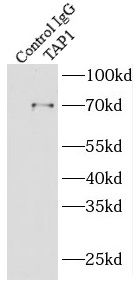Products
TAP1 antibody
| Synonyms: | Antigen peptide transporter 1 (APT1)|ATP-binding cassette sub-family B member 2|Peptide supply factor 1|Peptide transporter PSF1 (PSF-1)|Peptide transporter TAP1|Peptide transporter involved in antigen processing 1|Really interesting new gene 4 protein (RING4)|TAP1|ABCB2|PSF1|RING4|Y3 antibody | ||
| Catalogue No.: | FNab08499 | Reactivity: | Human, Mouse |
| Host: | Rabbit | Tested Application: | ELISA, IF, WB, IHC, IP |
| Clonality: | polyclonal | Isotype: | IgG |
| Size | Price |
|---|---|
| 100µg | Inquiry |
- SPECIFICATIONS
- CITATIONS
- FIGURES
- CONDITIONS
- FAQS
- Product Name
- TAP1 antibody
- Catalogue No.
- FNab08499
- Size
- 100μg
- Form
- liquid
- Purification
- Immunogen affinity purified
- Purity
- ≥95% as determined by SDS-PAGE
- Clonality
- polyclonal
- Isotype
- IgG
- Storage
- PBS with 0.02% sodium azide and 50% glycerol pH 7.3, -20℃ for 12 months(Avoid repeated freeze / thaw cycles.)
- Immunogen
- transporter 1, ATP-binding cassette, sub-family B(MDR/TAP)
- Alternative Names
- Antigen peptide transporter 1 (APT1)|ATP-binding cassette sub-family B member 2|Peptide supply factor 1|Peptide transporter PSF1 (PSF-1)|Peptide transporter TAP1|Peptide transporter involved in antigen processing 1|Really interesting new gene 4 protein (RING4)|TAP1|ABCB2|PSF1|RING4|Y3 antibody
- UniProt ID
- Q03518
- Observed MW
- 70-81 kDa
- Tested Applications
- ELISA, IF, WB, IHC, IP
- Recommended dilution
- WB: 1:500-1:2000; IP: 1:200-1:2000; IHC: 1:20-1:200; IF: 1:20-1:200
 HepG2 cells were subjected to SDS PAGE followed by western blot with FNab08499(TAP1 Antibody) at dilution of 1:1000
HepG2 cells were subjected to SDS PAGE followed by western blot with FNab08499(TAP1 Antibody) at dilution of 1:1000
 IP Result of anti-TAP1 (IP:FNab08499, 4ug; Detection:FNab08499 1:500) with HepG2 cells lysate 2400ug.
IP Result of anti-TAP1 (IP:FNab08499, 4ug; Detection:FNab08499 1:500) with HepG2 cells lysate 2400ug.
 Immunohistochemistry of paraffin-embedded human pancreas cancer tissue slide using FNab08499(TAP1 Antibody) at dilution of 1:50
Immunohistochemistry of paraffin-embedded human pancreas cancer tissue slide using FNab08499(TAP1 Antibody) at dilution of 1:50
- Background
- Involved in the transport of antigens from the cytoplasm to the endoplasmic reticulum for association with MHC class I molecules. Also acts as a molecular scaffold for the final stage of MHC class I folding, namely the binding of peptide. Nascent MHC class I molecules associate with TAP via tapasin. Inhibited by the covalent attachment of herpes simplex virus ICP47 protein, which blocks the peptide-binding site of TAP. Inhibited by human cytomegalovirus US6 glycoprotein, which binds to the lumenal side of the TAP complex and inhibits peptide translocation by specifically blocking ATP-binding to TAP1 and prevents the conformational rearrangement of TAP induced by peptide binding. Inhibited by human adenovirus E3-19K glycoprotein, which binds the TAP complex and acts as a tapasin inhibitor, preventing MHC class I/TAP association. Expression of TAP1 is down-regulated by human Epstein-Barr virus vIL-10 protein, thereby affecting the transport of peptides into the endoplasmic reticulum and subsequent peptide loading by MHC class I molecules.
- Journal:
- Acta Tropica
- Author:
- Laboratório de Imunologia Celular Aplicada à Saúde, Funda??o Oswaldo Cruz, FIOCRUZ Rond?nia, Porto Velho, RO, Brazil.
- Cited Date:
- 2024-10-18
- Product:
How many times can antibodies be recycled?
First, usually it's not suggested to recycle antibodies. After use, buffer system of antibodies has changed. The storage condition of recycled antibodies for different customers also varies. Thus, the performance efficiency of recycled antibodies can’t be guaranteed. Besides, FineTest ever conducted the antibody recycling assay. Assay results show recycling times of different antibodies also varies. Usually, higher antibody titer allows more repeated use. Customers can determine based on experimental requirements.
Notes: After incubation, we recycle rest antibodies to centrifuge tube and store at 4℃. High titer antibodies can be stored for a minimum of one week. Reuse about three times.
What are components of FineTest antibody buffer?
Components of FineTest antibody buffer are usually PBS with proclin300 or sodium azide, BSA, 50% glycerol. Common preservative is proclin300 or sodium azide, which is widely applied in the lab and industry.
How about the storage temperature and duration of FineTest antibodies?
Most antibodies are stored at -20℃. Directly-labeled flow cytometry antibodies should be stored at 2 - 8℃. The shelf life is one year. If after sales issues for purchased antibodies appear, return or replacement is available. Usually, antibodies can be still used after the one-year warranty. We can offer technical support services.
Is dilution required for FineTest antibodies? What’s the dilute solution?
Directly-labeled flow cytometry antibodies are ready-to-use without dilution. Other antibodies are usually concentrated. Follow the dilution ratio suggested in the manual. Dilute solution for different experiments also varies. Common antibody dilution buffers are acceptable(e.g. PBST, TBST, antibody blocking buffer).
How to retrieve antibodies for immunohistochemistry?
Common retrieval buffers: Tris-EDTA Buffer(pH 9.0); Citrate Buffer(pH 6.0)
Heat induced antibody retrieval:
Method 1: Water-bath heating: Put the beaker with retrieval buffer and slide in the boiling water bath. Keep the boiling state for 15min. Naturally cool to room temperature;
Method 2: Microwave retrieval: Put the beaker with retrieval buffer and slide in the microwave oven. Heat at high power for 5min, Switch OFF for 3min, Heat at medium power for 5min. Naturally cool to room temperature.
How to choose secondary antibodies?
(1) Secondary antibodies react with primary antibodies. Thus, secondary antibodies should be against host species of primary antibodies. E.g. If the primary antibody is derived from rabbit, the relevant secondary antibody should be against rabbit. E.g. goat anti rabbit or donkey anti rabbit.
(2) Choose secondary antibody conjugates according to the experimental type, e.g. ELISA, WB, IHC etc. Common enzyme conjugated secondary antibodies are labelled by HRP, AP etc. Fluorescin or dye labelled secondary antibodies are applied in immunofluorescence and flow cytometry(e.g. FITC, Cy3).
